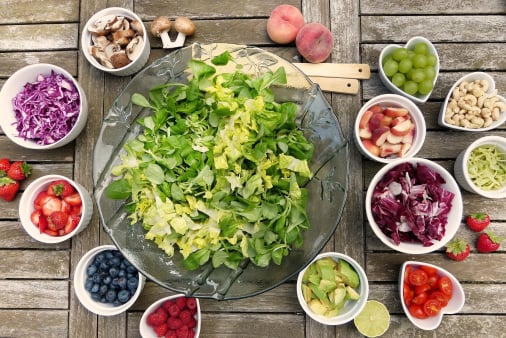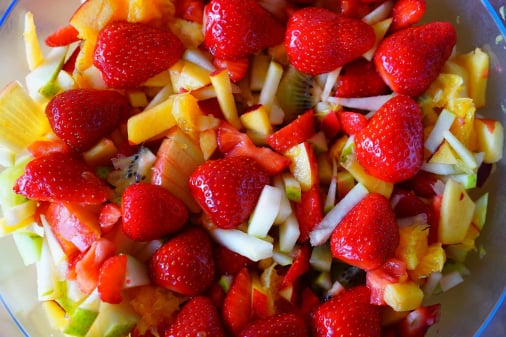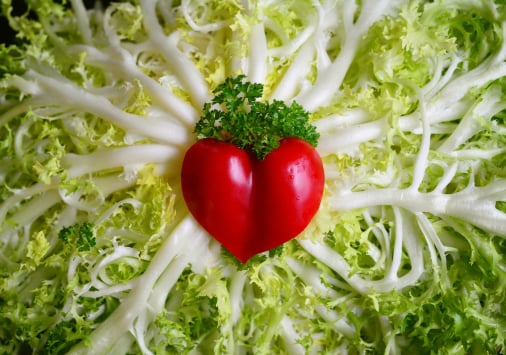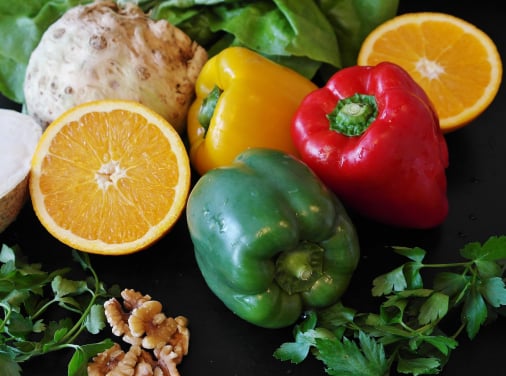Salad traceability app:
Salad traceability app manages the entire washing, sorting, salad mixing, and salad packing process to guarantee maximum food safety and salad traceability for salad packers and food service companies. Easy salad recall traceability, audit, and quality inspections.

Salad Traceability during production
View Traceability App Specifications.
SALAD TRACEABILITY REQUIREMENTS
Farm-to-Table Traceability Is on Its Way: FDA Issues Proposed Rule
On September 23, the U.S. Food and Drug Administration (FDA) published a proposed rule to establish additional traceability recordkeeping requirements for companies that manufacture, process, pack, or hold certain high-risk foods listed on a newly formulated proposed Food Traceability List (FTL). You can find the proposed rule here.
At the core of this proposed rule is the requirement that those companies that “manufacture, process, pack, or hold foods on the FTL would be required to establish and maintain records containing Key Data Elements (KDEs) associated with different Critical Tracking Events (CTEs) …”
That is a mouthful of acronyms – but it is easy to determine if the proposed rule may apply to your company and expected requirements by focusing on the definitions of FTLs, CTEs, and KDEs:
Food Traceability List (FTL) – This is the list of foods that the proposed rule applies to. We have included the proposed FTL in the table below.
Critical Tracking Events (CTEs) – If your company manufactures, processes, packs, or holds a food on the FTL, then the proposed rule requires your company to maintain additional records depending on the type of supply chain activity. CTEs cover all events in the supply chain – including, for example, the “growing, receiving (including receipt by a first receiver), transforming, creating, or shipping of the food.”
Key Data Elements (KDEs) – A KDE is information a company must keep and maintain in a record based on the type of supply chain activity performed (i.e., the CTE identified above). FDA identified which KDEs would be necessary to effectively trace a product based on the CTEs performed in the proposed rule.
Ultimately, the purpose of the proposed recordkeeping requirement for those “high risk” foods on the FTL is to allow for rapid FDA action to identify recipients of food in order to prevent or mitigate serious adverse health consequences caused by adulterated or misbranded foods.
1. Proposed Food Traceability List (FTL):
In developing the proposed rule, FDA employed a risk-ranking model consistent with the factors set forth in Section 204(d)(2) of the Food Safety Modernization Act (FSMA) to develop the FTL. This risk-ranking model will apply to those foods listed in the FTL as well as those foods that contain the FTL-listed foods. At this time, the FTL is limited to foods intended for human consumption, but FDA may consider application to animal foods in future reassessments using the risk-ranking model. FDA proposes that any future deletions it makes to the list will become effective immediately and future additions will become effective a year after the date of publication in the Federal Register.

Salad packhouse hygiene checklist
Ready-to-eat deli salads
Includes all types of ready-to-eat deli salads, such as egg salad, potato salad, pasta salad, and seafood salad; does not include meat salads
2. Important Points for Companies Subject to the Proposed Rule:
Establishment of traceability lot codes: Food facilities must establish traceability lot codes for foods subject to the FTL at the time the facility originates, transforms, or creates the food.
Development of Traceability Program: Those food facilities subject to the traceability requirements must develop a traceability program for the foods they manufacture, process, pack, or hold. The type of records that must be established and maintained will depend on the activities undertaken by the food establishment, with each activity (growing, receiving, transforming, creating, and shipping) subject to unique requirements. However, all such entities must establish and maintain the following information:
A description of the reference records maintained, where they are, and how the referenced records for different tracing events are linked
A list of foods on the traceability list that the food establishment ships, including the traceability product identifier and traceability product description for each food
A description of how traceability lot codes are established and assigned
Any other information necessary to understand the data within any required record (e.g., coding systems, glossaries, abbreviations)
Complete Supply Chain: In addition to establishing and maintaining the required records, receivers and shippers must assure that certain records are received and sent respectively in order to assure a complete supply chain.
Record Maintenance and Availability: Records must be maintained for two (2) years unless specified elsewhere (for example, records that must be retained by retail food establishments and institutions operating farm to school programs are required to establish and retain records regarding the name and address of the farm that was the source of the food for 180 days). To the extent that existing records satisfy the records requirement, such as those maintained in the ordinary course of business, there is no need to duplicate such records. Such records must be made available within 24 hours after an FDA request.
Failure to Comply: Failure to comply with these requirements, once finalized, is a prohibited act under Section 301(e) of the FFDCA unless committed by a farm. Such food can be refused admission when offered for import.
3. Foods and Facilities Excluded or Partially Excluded:
There are a number of important proposed exclusions or partial exclusions from the traceability requirements, many of which track similar exclusions set forth in other FSMA requirements.

Salad Traceability management
Processed food: food that receives commercial processing that reduces the presence of microorganisms of public health consequences as long as they meet the requirements for exclusion from the Produce Safety Rule under 21 C.F.R 112.2(b)
Shell eggs that receive “treatments” as that term is defined in the Egg Safety Rule to reduce the risk of Salmonella enteritidis, and that comply with 21 C.F.R. 118.1(a)(2)
Foods rarely consumed raw as set forth in 21 C.F.R. 112.2(a)(1)
Certain foods produced and packaged and properly labeled on a farm when the packaging remains intact and prevents contamination or alteration of the food until the food reaches the consumer
Foods sold directly to consumers from the farm on which it is grown.
Walmart requires suppliers to use traceability system for leafy greens
Walmart has unveiled a new food safety program that will require suppliers of fresh leafy greens to use a blockchain-based solution the retailer piloted with IBM.
Called the Walmart Food Traceability Initiative, the effort aims to provide suppliers the ability to trace fresh, leafy produce from farm to table in real time using the IBM Food Trust Network. Walmart said blockchain enables digitized sharing of data in a secure, trusted manner, allowing more open access to information gathered by suppliers.
Walmart and Sam’s Club yesterday sent letters to suppliers of these products to inform them of the change. Suppliers will be required to capture digital traceability event information using the IBM system and be up and running on the network in about a year.
The timetable set by Walmart allows direct suppliers to comply in two phases: one-step back traceability on the blockchain network by Jan. 31 and end-to-end traceability back to the farm by Sept. 30, 2019.
“Customers trust us to help them put quality food on their tables for themselves and their families,” Charles Redfield, executive vice president of food for Walmart U.S., said in a statement. “We have to go further than offering great food at an everyday low price. Our customers need to know they can trust us to help ensure that food is safe. These new requirements will help us do just that.”
Walmart
Walmart said the traceability push stems from a recent series of high-profile recalls from salmonella and E. coli contaminations — notably the multistate outbreak of E. coli O157:H7 linked to romaine lettuce.

Salad Supplier Traceability
“Although the FDA and CDC were able to inform consumers, producers and retailers that the romaine lettuce associated with illnesses came from the Yuma (Ariz.) growing region in general, health officials and industry professionals were unable to quickly determine which lots were affected and which were not,” Walmart explained in the supplier letter. “This resulted in millions of bags and heads of romaine lettuce having to be removed from the marketplace and a loss of consumer confidence in romaine lettuce, regardless of growing region, as well as negatively affecting the economic livelihood of many, including farmers.”
The company reported that the outbreak led to 210 confirmed cases of E. coli infection and caused 96 hospitalizations and five deaths.
“It was difficult for consumers to know how to determine where their lettuce was grown,” according to Frank Yiannas, vice president of food safety at Walmart. “None of the bags of salad had ‘Yuma, Arizona’ on them. In the future, using the technology we’re requiring, a customer could potentially scan a bag of salad and know with certainty where it came from.”
Technology that enables leafy greens and other products to be traced back to the source quickly during an outbreak can minimize the consumer health impact and reduce losses of uncontaminated products incorrectly linked to an outbreak, Walmart noted in the letter. In addition, such capability would allow health officials to conduct faster, more comprehensive root-cause analysis to aid future prevention efforts.
“Walmart believes the current one-step-up and one-step-back model of food traceability is outdated for the 21st century and that, by working together, we can do better,” the company told suppliers.
Walmart and a number of its suppliers, including Dole Fresh Vegetables, tested the IBM solution over the past 18 months. Using the IBM blockchain technology, the participants found they could cut the time it takes to track a food item from a Walmart store back to source in seconds instead of days or even weeks, the Bentonville, Ark.-based company said.
Yiannas illustrated the current challenge: Using paper-based ledgers may take seven days to track down a product’s source, and a typical grocery store stocks 70,000 food items.
“The food system is absolutely too large for any single entity to [track],” Yiannas explained. “We’ve been working with IBM to digitize that so the information is captured on the farm with a handheld system. It’s [also] captured at the packing house at the supplier.”
To help suppliers get going on the IBM Food Trust network, Walmart and IBM have provided instructions at http://ibm.com/food/getstarted. The companies also have posted a list of frequently asked questions and plan to post prerecorded webinars to explain the new requirement and how suppliers can comply.
Also signing the supplier letter with Redfield and Yiannis were Martin Mundo, senior vice president and GMM for produce and global produce sourcing at Walmart, and Russell Mounce, vice president and GMM for produce, floral and bakery at Sam’s Club.
Lettuce Talk Traceability
by Bridget Conley | Dec 11, 2020 | Food Marketing/PR, Food Safety, Nutrition/Labeling, Packaging/Supplies, Production Traceability, Production/Operations, Resources
While the FDA and CDC narrowed down the area in central California they believe the contaminated lettuce was grown, they have yet to pinpoint the source or point of contamination of what is the 3rd E. Coli outbreak in 2 years.
“Traceback activities in this romaine lettuce investigation are ongoing and new information continues to be gathered. Analysis of information available through November 30 has not narrowed the potential sources of contaminated romaine lettuce to a specific farm, processor, shipper, or distribution center.”
The FDA and CDC decided to play it safe before Thanksgiving urging all retailers and consumers to throw away any products containing romaine lettuce. They recommended removing products from the market because they could not produce any data to tie the reported cases to a specific source of any kind. While they have since stated lettuce grown hydroponically and outside the area of central California are safe to eat; it is strongly advised to avoid any products that do not contain labels with harvest dates and locations.
Fresh produce does present unique challenges regarding the ability to label individual units; however, there are ways to accurately track product with barcodes and an ERP/ digital platform. With limited amounts of information available to investigators, the FDA is still searching for the original source of the outbreak. If more data pertaining to the lettuce were available to investigators, this timeline could be greatly reduced as would the number of E. Coli cases reported.
This recall is a great example of the importance of maintaining stock lot information throughout the entire production process all the way through to customers or distributors. ERPs can track stock lot information from seed to sale and everything in between by digitally recording and tracking harvest locations, dates, labels, shipment records, and customer and vendor records. The use of an ERP system allows for quick and easy insight into critical data, removing dangerous product quickly, ultimately saving lives with a few calculated clicks.